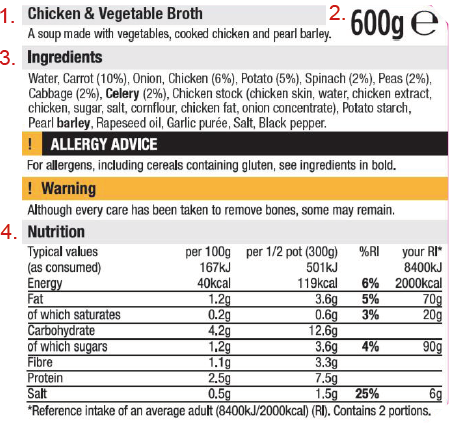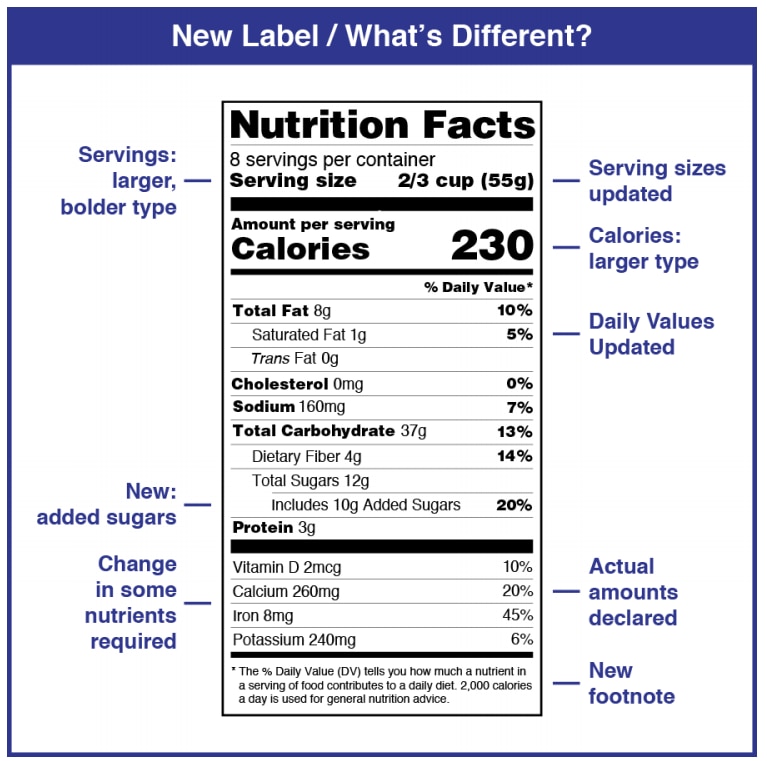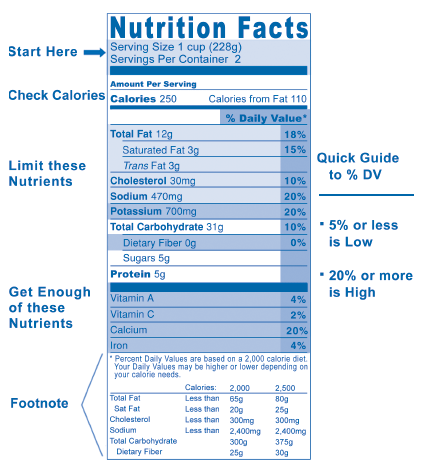38 nutrition label reading handout
Quick Tips for Reading the Nutrition Facts Label - Food and Drug ... Quick Tips for Reading the Nutrition Facts Label Use Percent Daily Value (%DV) as a guide. The %DV shows how much a nutrient in a serving of the food contributes to a total daily diet. As a general... PDF Label reading basics for diabetes - Veterans Affairs Label Reading Basics for Diabetes Nutrition and Food Services (05/2020) Serving Size • The serving size is the portion size used for all the values on the label. • Different foods have different serving sizes. • The serving size on this label is 2/3 cup. Servings per Container • Indicates the number of
Label reading fact sheet - Baker Heart and Diabetes Institute After you have checked the Nutrition Information. Panel you may also be interested in checking the ingredients list. Ingredients are listed from.

Nutrition label reading handout
How To Read Nutrition Labels Handout | RD2RD How To Read Nutrition Labels Handout. This PDF includes a quick & easy 5 step guide to reading a nutrition label. This product is easily designable: change the fonts and colors to match your branding! After downloading the PDF, open Canva, the free website at and drag & drop the PDF to open and customize. PDF A Guide to Reading Food Labels - University of Rochester Make healthy choices easier by understanding the sections of the Nutrition Facts label. 1. Serving Size. The serving size is a measured amount of food. In the sample label, the serving size is one cup, and there are two servings per container. If you ate the whole container, you would eat two cups, which doubles the calories and other nutrient ... How To Read Food and Beverage Labels - National Institute on Aging Or you can call the U.S. Department of Agriculture's Food and Nutrition Information Center at 301-504-5414. Understanding percent Daily Value (% DV) The percent Daily Value (% DV) tells how much a nutrient in a serving of the food or beverage contributes to a total daily 2,000-calorie diet.
Nutrition label reading handout. PDF 2.2 Reading Nutrition Labels Handout - Michigan State University 2.2: Reading Nutrition Labels Handout The cells of animals, plants, and decomposers are all made mostly of: • Water, and • Large organic molecules: Fats, proteins, and carbohydrates Here's how to use nutrition labels to find out about different kinds of cells. We'll use carrots as an example. Reading Food Labels | ADA - American Diabetes Association The Nutrition Facts labels on foods are really the key to making the best choices. We'll cover the basics so that these labels make shopping easier for you. Get started Understanding Carbs You've heard it all. From carb-free to low-carb, to whole and empty carbs, it's hard to know what it all means. Learn more Food & Blood Sugar PDF TO CARE 4 YOURSELF READING A NUTRITION FACTS LABEL - novoMEDLINK Those labels tell you just about everything you need to know to make healthy food choices. So it's a good idea to learn to read them. Here's how. Nutrition Facts Serving Size ½ cup (130g) Servings Per Container About 3.5 Calories110Calories from Fat20 0% 3% 0% 14% 6% 24% Iron 8% * Percent Daily Values are based on a 2,000 calorie diet. Food Labels | Nutrition.gov What's New with the Nutrition Facts Label. HHS, Food and Drug Administration. The U.S. Food and Drug Administration (FDA) has updated the Nutrition Facts label on packaged foods and beverages with a fresh design that will make it easier for you to make informed food choices that contribute to lifelong healthy eating habits. What's in a Name?
PDF Missoula County Public Schools / Homepage Calories measure the amount of energy in the bonds of the carrot's organic materials. Cholesterol, sodium (in salt), vitamins, and minerals all add up to less than 1% of the carrot. About 1% of the carrot is protein. How to Read a Nutrition Facts Label size" is the official term used on food labels. Nutrition facts given on the food label are based on one serving. Be sure to look at the number of servings in the container. Even small containers may have more than one serving. If you eat the whole container, then you must multiply the nutrition values by the number of servings in the ... PDF Reading food labels - Queensland Health Reading food labels . Understanding how to read food labels can help you make healthy food choices. Food Standards Australia and New Zealand (FSANZ) regulates food labelling in Australia. Most packaged food and drink must have a nutrition information panel. Exceptions include those in very small packages, some baked products and take-away food ... The Nutrition Facts Label - Food and Drug Administration a day is used for general nutrition advice. Vitamin D 2mcg Calcium 260mg Iron 6mg Potassium 240mg 10% 20% 35% 6% Choose Nutrients Nutrients To Wisely Get More Of Compare and choose foods to get...
Label reading - Baker Fact sheets. Label reading. This fact sheet gives you guidance on understanding how to read nutrition information panels to help you identify healthy choices. This fact sheet will allow you to identify processed and packaged foods that are: lower in energy (kJ) lower in saturated and trans fat. lower in sugar. lower in sodium (salt) Nutrition Facts Label Guide | NHLBI, NIH Learn more about web-only publications. Food labels can help you make healthier choices. Here's information on how read labels on food packaging to help you make quick, informed decisions about the what foods to choose. Keywords: DASH, High Blood Pressure, Heart-Healthy Living. Label Reading the Healthy Way - Alberta Health Services Nutrition Facts Per 1 cup (30 g) Calories 180 % Daily Value* Fat 2 g 3 % Saturated 0.4 g + Trans 0 g 2 % Carbohydrate 35 g Fibre 4 g 15 % Sugars 7 g 7 % Protein 5 g Cholesterol 0 mg Sodium 120 mg 5 % Potassium 450 mg 10 % Calcium 30 mg 2 % Iron 8 mg 45 % PDF Shop Smart - Get the Facts on the New Food Labels - eatrightPRO food labels and start making healthier choices today. • Find out which foods are good sources of dietary fiber, vitamin D, calcium, iron, and potassium. • Compare similar foods to find one that meets your calorie needs. • Look for foods that are lower in saturated fat, trans fat, sodium, and added sugars. Source: FDA FOR REFERENCE ONLY
Eat Right Nutrition Tips and Handouts Eat Right Nutrition Tips and Handouts The Academy has created a number of handouts that members can use for client educational resources as well as flyers that can be used to highlight the expertise of registered dietitian nutritionists. Eat Right Tips (Handouts) 20 Health Tips 20 Ways to Enjoy More Fruits and Vegetables
Learn How the Nutrition Facts Label Can Help You Improve Your Health Nutrients Required on Label Vitamin D and potassium values are required. Calcium and iron will continue to be required. Vitamins A and C will no longer be required but can be included on a voluntary basis. Slight Decrease in Sodium Allowance The daily limit for sodium decreased slightly from 2,400 mg per day to 2,300 mg per day.
How to Read the Food Label - UCSC Risk Services Estimates range from 1,600 to 2,400 calories for women and 2,000 to 3,000 calories for men. If you're trying to lose weight, avoid or limit high-calorie foods. Percent Daily Value (DV) This is a percentage of the recommended daily amount of a nutrient in one serving. DV is based on a 2,000-calorie per day diet.
PDF Label reading fact sheet | Baker Institute Label reading Nutrition Information Panel To compare products, use the targets below: Sodium (salt) Aim for less than 400mg per 100g. Less than 120mg per 100g is better. Energy For snacks, aim for less than 600kJ per serve. Saturated fat Aim for less than 2g per 100g. Oils, cheese, nuts and seeds will have more saturated fat.
PDF Eat Right Become a smart shopper by reading food labels to find out more about the foods you eat. The Nutrition Facts panel found on most food labels will be changing in the near future, and the updates will help you: • Find out which foods are good sources of dietary fiber, vitamin D, calcium, iron, and potassium
Understanding Food Nutrition Labels | American Heart Association 1 - Start with the serving information at the top. This will tell you the size of a single serving and the total number of servings per container (package). 2 - Next, check total calories per serving and container. Pay attention to the calories per serving and how many calories you're really consuming if you eat the whole package.
Using the Nutrition Facts Table: % Daily Value - Canada.ca serving sizes) in the Nutrition Facts tables. Cracker A has 9 crackers and weighs 23 grams. Cracker B has 4 crackers and weighs 20 grams. Because the weights are similar, you can compare these Nutrition Facts tables. READ the % DVs Since you are comparing crackers, you may want to look at the % DVs for saturated and trans fats, sodium and fibre.
PDF Food and Nutrition Reading Nutrition Labels - University of Washington This handout explains the information on the Nutrition Facts label on packaged foods. Nutrition Label Information. Amounts listed on the nutrition label may be rounded to the nearest whole number. Serving Size and Number of Servings . Under "Nutrition Facts," you will find the serving size that is used for the nutrition information on the ...
Food Labels Nutrition Printables- Food Label Worksheets, Printout ... Food labels provide basic information about the nutrition inside foods so that children can begin to see how foods are different. Our learning and activities sheets make learning to read food labels fun for kids. Chef Solus takes the mystery out of the food labels so kids can develop healthy habits at a young age.
Food Labels | CDC - Centers for Disease Control and Prevention If you eat the whole thing, you are eating 8 times the amount of calories, carbs, fat, etc., shown on the label. Total Carbohydrate shows you types of carbs in the food, including sugar and fiber. Choose foods with more fiber, vitamins, and minerals. Choose foods with lower calories, saturated fat, sodium, and added sugars.
PDF Reading the nutrition label on a product is no easy task! Here are some ... If you eat the entire package (in this case - 6 servings) you'll need to multiply the nutrition facts by 6. For example, there are 250 calories in one bar; if you eat 6 servings that's 1500 calories. • 5% or less is low, 20% or more is high on average for 2,000 calories/day. • Look for products with 10% or less of the Daily Value (%DV) per serving.
Printable Materials and Handouts | Nutrition.gov This one-page handout highlights the key changes being made to the new Nutrition Facts Label. Tips to Reduce Food Waste - Print & Share HHS, Food and Drug Administration Share these tips to reduce food waste, save money, and protect the environment. NHLBI Publications and Resources: DASH Diet
How To Read Food and Beverage Labels - National Institute on Aging Or you can call the U.S. Department of Agriculture's Food and Nutrition Information Center at 301-504-5414. Understanding percent Daily Value (% DV) The percent Daily Value (% DV) tells how much a nutrient in a serving of the food or beverage contributes to a total daily 2,000-calorie diet.
PDF A Guide to Reading Food Labels - University of Rochester Make healthy choices easier by understanding the sections of the Nutrition Facts label. 1. Serving Size. The serving size is a measured amount of food. In the sample label, the serving size is one cup, and there are two servings per container. If you ate the whole container, you would eat two cups, which doubles the calories and other nutrient ...
How To Read Nutrition Labels Handout | RD2RD How To Read Nutrition Labels Handout. This PDF includes a quick & easy 5 step guide to reading a nutrition label. This product is easily designable: change the fonts and colors to match your branding! After downloading the PDF, open Canva, the free website at and drag & drop the PDF to open and customize.






























Komentar
Posting Komentar